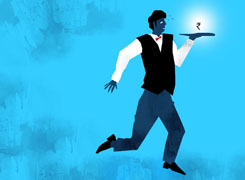Ramalingam Kalirajan |8285 Answers |Ask -Follow
Mutual Funds, Financial Planning Expert - Answered on May 16, 2024
He has an MBA in finance from the University of Madras and is a certified financial planner.
He is the director and chief financial planner at Holistic Investment, a Chennai-based firm that offers financial planning and wealth management advice.... more

I am 49 yrs with monthly expense of 2 Lakhs and corpus of 7 CR so can i retire now with life expectancy of 75 yrs
At 49 years old, contemplating retirement with a monthly expense of ?2 lakhs and a corpus of ?7 crores is a significant decision. Let's delve into whether you can comfortably retire now, considering a life expectancy of 75 years.
Evaluating Financial Stability
With annual expenses totaling ?24 lakhs, we must ascertain if your corpus can sustain your lifestyle throughout retirement. Calculating your withdrawal rate from the corpus is crucial.
Withdrawal Rate Assessment
Dividing annual expenses by retirement corpus:
?24 lakhs / ?7 crores = 0.342.......
Your withdrawal rate is approximately 3.43%.
Sustainable Withdrawal Rate
A withdrawal rate around 4% is often deemed safe for retirement planning. Your rate of 3.43% suggests that your corpus may adequately support your expenses in retirement.
Longevity Considerations
Given your life expectancy of 75 years, it's prudent to acknowledge the possibility of living longer. Advancements in healthcare indicate the need for financial preparedness beyond this age.
Risk Management Strategies
To address longevity risk and safeguard financial security:
Regularly reassess expenses and adjust withdrawal rates to accommodate inflation and lifestyle changes.
Diversify investments across asset classes to optimize returns and mitigate risk.
Periodically review retirement plans with a Certified Financial Planner to ensure alignment with goals.
Conclusion
Your financial situation suggests that retiring now could be feasible, given your corpus and expenses. However, it's imperative to remain vigilant regarding longevity risk and inflation to ensure sustained financial well-being throughout retirement.
Best Regards,
K. Ramalingam, MBA, CFP,
Chief Financial Planner,
www.holisticinvestment.in
You may like to see similar questions and answers below
Ramalingam Kalirajan |8285 Answers |Ask -Follow
Mutual Funds, Financial Planning Expert - Answered on Nov 02, 2024
Milind Vadjikar |1188 Answers |Ask -Follow
Insurance, Stocks, MF, PF Expert - Answered on Dec 24, 2024
Ramalingam Kalirajan |8285 Answers |Ask -Follow
Mutual Funds, Financial Planning Expert - Answered on Jan 20, 2025
Ramalingam Kalirajan |8285 Answers |Ask -Follow
Mutual Funds, Financial Planning Expert - Answered on Feb 04, 2025
Radheshyam Zanwar |1563 Answers |Ask -Follow
MHT-CET, IIT-JEE, NEET-UG Expert - Answered on Apr 24, 2025
Sushil Sukhwani |594 Answers |Ask -Follow
Study Abroad Expert - Answered on Apr 24, 2025
Sushil Sukhwani |594 Answers |Ask -Follow
Study Abroad Expert - Answered on Apr 24, 2025
Sushil Sukhwani |594 Answers |Ask -Follow
Study Abroad Expert - Answered on Apr 24, 2025
Patrick Dsouza |1029 Answers |Ask -Follow
CAT, XAT, CMAT, CET Expert - Answered on Apr 24, 2025
Nayagam P P |4455 Answers |Ask -Follow
Career Counsellor - Answered on Apr 24, 2025
Patrick Dsouza |1029 Answers |Ask -Follow
CAT, XAT, CMAT, CET Expert - Answered on Apr 24, 2025
Mayank Chandel |2236 Answers |Ask -Follow
IIT-JEE, NEET-UG, SAT, CLAT, CA, CS Exam Expert - Answered on Apr 24, 2025
Nayagam P P |4455 Answers |Ask -Follow
Career Counsellor - Answered on Apr 24, 2025
Mayank Chandel |2236 Answers |Ask -Follow
IIT-JEE, NEET-UG, SAT, CLAT, CA, CS Exam Expert - Answered on Apr 24, 2025






















